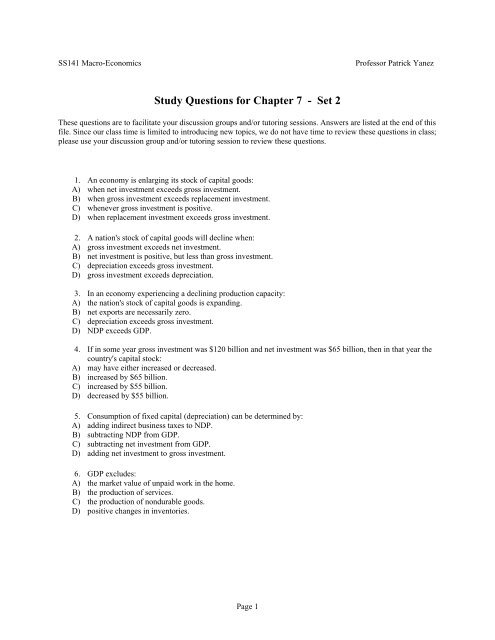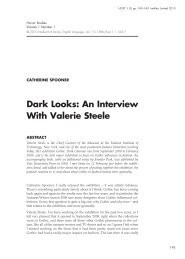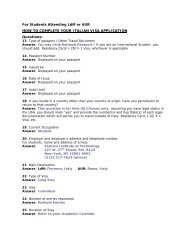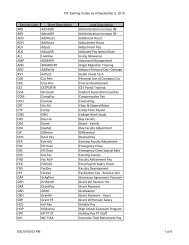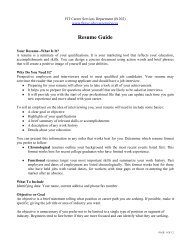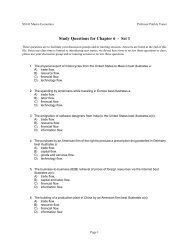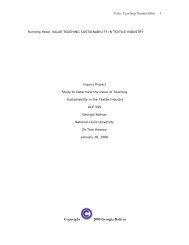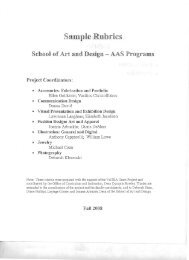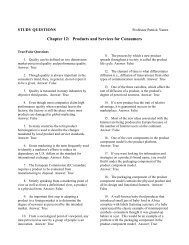Study Questions for Chapter 7 - Set 2
Study Questions for Chapter 7 - Set 2
Study Questions for Chapter 7 - Set 2
Create successful ePaper yourself
Turn your PDF publications into a flip-book with our unique Google optimized e-Paper software.
SS141 Macro-Economics Professor Patrick Yanez<br />
<strong>Study</strong> <strong>Questions</strong> <strong>for</strong> <strong>Chapter</strong> 7 - <strong>Set</strong> 2<br />
These questions are to facilitate your discussion groups and/or tutoring sessions. Answers are listed at the end of this<br />
file. Since our class time is limited to introducing new topics, we do not have time to review these questions in class;<br />
please use your discussion group and/or tutoring session to review these questions.<br />
1. An economy is enlarging its stock of capital goods:<br />
A) when net investment exceeds gross investment.<br />
B) when gross investment exceeds replacement investment.<br />
C) whenever gross investment is positive.<br />
D) when replacement investment exceeds gross investment.<br />
2. A nation's stock of capital goods will decline when:<br />
A) gross investment exceeds net investment.<br />
B) net investment is positive, but less than gross investment.<br />
C) depreciation exceeds gross investment.<br />
D) gross investment exceeds depreciation.<br />
3. In an economy experiencing a declining production capacity:<br />
A) the nation's stock of capital goods is expanding.<br />
B) net exports are necessarily zero.<br />
C) depreciation exceeds gross investment.<br />
D) NDP exceeds GDP.<br />
4. If in some year gross investment was $120 billion and net investment was $65 billion, then in that year the<br />
country's capital stock:<br />
A) may have either increased or decreased.<br />
B) increased by $65 billion.<br />
C) increased by $55 billion.<br />
D) decreased by $55 billion.<br />
5. Consumption of fixed capital (depreciation) can be determined by:<br />
A) adding indirect business taxes to NDP.<br />
B) subtracting NDP from GDP.<br />
C) subtracting net investment from GDP.<br />
D) adding net investment to gross investment.<br />
6. GDP excludes:<br />
A) the market value of unpaid work in the home.<br />
B) the production of services.<br />
C) the production of nondurable goods.<br />
D) positive changes in inventories.<br />
Page 1
Use the following to answer questions 7-11:<br />
Answer the next question(s) on the basis of the following data. All figures are in billions of dollars.<br />
Personal taxes $ 40<br />
Social security contributions 15<br />
Indirect business taxes 20<br />
Corporate income taxes 40<br />
Transfer payments 22<br />
U.S. exports 24<br />
Undistributed corporate profits 35<br />
Government purchases 90<br />
Gross private domestic investment 75<br />
U.S. imports 22<br />
Personal consumption expenditures 250<br />
Consumption of fixed capital 25<br />
Net <strong>for</strong>eign factor income earned in the U.S. 10<br />
7. Refer to the above data. GDP is:<br />
A) $390.<br />
B) $417.<br />
C) $422.<br />
D) $492.<br />
E) $512.<br />
8. Refer to the above data. NDP is:<br />
A) $370.<br />
B) $402.<br />
C) $392.<br />
D) $467.<br />
9. Refer to the above data. NI is:<br />
A) $364.<br />
B) $372.<br />
C) $447.<br />
D) $362.<br />
10. Refer to the above data. PI is:<br />
A) $294.<br />
B) $346.<br />
C) $408.<br />
D) $437.<br />
11. Refer to the above data. DI is:<br />
A) $284.<br />
B) $329.<br />
C) $254.<br />
D) $402.<br />
Page 2
Use the following to answer questions 12-15:<br />
Answer the next question(s) on the basis of the following data. All figures are in billions of dollars.<br />
Gross investment $ 18<br />
National income 100<br />
Net exports 2<br />
Personal income 85<br />
Personal consumption expenditures 70<br />
Saving 5<br />
Government purchases 20<br />
Net domestic product 105<br />
12. The gross domestic product <strong>for</strong> the above economy is:<br />
A) $100.<br />
B) $95.<br />
C) $110.<br />
D) $107.<br />
13. Refer to the above data. Consumption of fixed capital is:<br />
A) $5.<br />
B) $10.<br />
C) $20.<br />
D) $30.<br />
14. Refer to the above data. Disposable income is:<br />
A) $83.<br />
B) $73.<br />
C) $75.<br />
D) $77.<br />
15. Refer to the above data. From this in<strong>for</strong>mation we can conclude that the sum of indirect business taxes and<br />
net <strong>for</strong>eign factor income is.<br />
A) $5 billion.<br />
B) zero.<br />
C) $1 billion.<br />
D) $15 billion.<br />
16. "Value added" refers to:<br />
A) any increase in GDP that has been adjusted <strong>for</strong> adverse environmental effects.<br />
B) the excess of gross investment over net investment.<br />
C) the difference between the value of a firm's output and the value of the inputs it has purchased from others.<br />
D) the portion of any increase in GDP that is caused by inflation as opposed to an increase in real output.<br />
17. Assume a manufacturer of stereo speakers purchases $40 worth of components <strong>for</strong> each speaker. The<br />
completed speaker sells <strong>for</strong> $70. The value added by the manufacturer <strong>for</strong> each speaker is:<br />
A) $110.<br />
B) $30.<br />
C) $40.<br />
D) $70.<br />
Page 3
18. <strong>Set</strong>up Corporation buys $100,000 of sand, rock, and cement to produce redi-mix concrete. It sells 10,000<br />
cubic yards of concrete at $30 a cubic yard. The value added by <strong>Set</strong>up Corporation is:<br />
A) $300,000.<br />
B) $100,000.<br />
C) $200,000.<br />
D) zero dollars.<br />
19. By summing the values added at each stage in the production of some good we obtain:<br />
A) the price of that good.<br />
B) the total income generated by that good's production.<br />
C) the total cost (including profits) of that product.<br />
D) all of the above.<br />
20. Value added can be determined by:<br />
A) summing the profits of all enterprises in the economy.<br />
B) subtracting the purchase of intermediate products from the value of the sales of final products.<br />
C) calculating the year-to-year changes in real GDP.<br />
D) deflating nominal GDP.<br />
21. Which of the following best defines national income?<br />
A) income received by households less personal taxes<br />
B) the be<strong>for</strong>e-tax income received by households<br />
C) all incomes earned by U.S. resource suppliers <strong>for</strong> their current contributions to production<br />
D) the market value of the annual output net of consumption of fixed capital<br />
22. The total amount of income earned by U.S. resource suppliers in a year is measured by:<br />
A) gross domestic product.<br />
B) national income.<br />
C) personal income.<br />
D) disposable income.<br />
23. The largest component of national income is:<br />
A) compensation of employees.<br />
B) rents.<br />
C) interest.<br />
D) corporate profits.<br />
24. The total income earned in any year by U.S. resource suppliers is measured by:<br />
A) DI.<br />
B) NI.<br />
C) PI.<br />
D) GDP.<br />
25. National income measures:<br />
A) nominal GDP after it has been inflated or deflated <strong>for</strong> changes in the value of the dollar.<br />
B) the after-tax income of resource suppliers.<br />
C) the market value or cost of the resources used in the production of the national output.<br />
D) the amount of wage, rent, interest, and profits income actually received by households.<br />
26. Personal income is most likely to exceed national income:<br />
A) when gross and net investment are equal.<br />
B) during a period of recession or depression.<br />
C) when gross investment exceeds net investment.<br />
D) during a period of extended inflation.<br />
Page 4
27. If personal income exceedes national income in a particular year, we can conclude that:<br />
A) transfer payments exceeded the sum of social security contributions, corporate income taxes, and indirect<br />
business taxes.<br />
B) the sum of social security contributions, corporate income taxes, and undistributed corporate profits<br />
exceeded transfer payments.<br />
C) consumption of fixed capital and indirect business taxes exceeded personal taxes.<br />
D) transfer payments exceeded the sum of social security contributions, corporate income taxes, and<br />
undistributed corporate profits.<br />
28. Which of the following best defines disposable income?<br />
A) income received by households less personal taxes<br />
B) the be<strong>for</strong>e-tax income received by households<br />
C) all income earned by resource suppliers <strong>for</strong> their current contributions to production<br />
D) the market value of the annual output net of consumption of fixed capital<br />
29. Which of the following is the largest dollar amount in the United States?<br />
A) disposable income<br />
B) personal income<br />
C) gross domestic product<br />
D) national income<br />
30. Which of the following is the smallest dollar amount in the United States?<br />
A) disposable income<br />
B) personal income<br />
C) gross domestic product<br />
D) national income<br />
31. Transfer payments are included in:<br />
A) NI.<br />
B) PI.<br />
C) GDP.<br />
D) NDP.<br />
32. The amount of after-tax income received by households is measured by:<br />
A) discretionary income.<br />
B) national income.<br />
C) disposable income.<br />
D) personal income.<br />
33. In a typical year which of the following measures of aggregate output and income is likely to be the<br />
smallest?<br />
A) gross domestic product<br />
B) national income<br />
C) disposable income<br />
D) personal income<br />
34. Nominal GDP is:<br />
A) the sum of all monetary transactions that occur in the economy in a year.<br />
B) the sum of all monetary transactions involving final goods and services that occur in the economy in a year.<br />
C) the amount of production that occurs when the economy is operating at full employment.<br />
D) money GDP adjusted <strong>for</strong> inflation.<br />
35. The term "real GDP" refers to:<br />
A) the value of the domestic output after adjustments have been made <strong>for</strong> environmental pollution and changes<br />
Page 5
in the distribution of income.<br />
B) GDP data that embody changes in the price level, but not changes in physical output.<br />
C) GDP data that reflect changes in both physical output and the price level.<br />
D) GDP data that have been adjusted <strong>for</strong> changes in the price level.<br />
36. Real GDP measures:<br />
A) current output at current prices.<br />
B) current output at base year prices.<br />
C) base year output at current prices.<br />
D) base year output at current exchange rates.<br />
37. Nominal GDP is adjusted <strong>for</strong> price changes through the use of:<br />
A) the Consumer Price Index (CPI).<br />
B) the Producer Price Index (PPI).<br />
C) the GDP price index.<br />
D) exchange rates.<br />
38. A price index is:<br />
A) a comparison of the price of a market basket from a fixed point of reference.<br />
B) a comparison of real GDP in one period relative to another.<br />
C) the cost of a market basket of goods and services in a base period divided by the cost of the same market<br />
basket in another period.<br />
D) a ratio of real GDP to nominal GDP.<br />
39. The GDP price index:<br />
A) includes fewer goods and services than the consumer price index.<br />
B) is identical to the consumer price index.<br />
C) is another term <strong>for</strong> the producer price index.<br />
D) includes all goods comprising the nation's domestic output.<br />
40. If real GDP falls from one period to another, we can conclude that:<br />
A) deflation occurred.<br />
B) inflation occurred.<br />
C) nominal GDP fell.<br />
D) none of the above necessarily occurred.<br />
41. In comparing GDP data over a period of years, a difference between nominal and real GDP may arise<br />
because:<br />
A) of changes in trade deficits and surpluses.<br />
B) the length of the workweek has declined historically.<br />
C) the price level may change over time.<br />
D) depreciation may be greater or smaller than gross investment.<br />
42. In an economy experiencing persistent deflation:<br />
A) potential GDP will necessarily exceed actual GDP.<br />
B) changes in nominal GDP may either overstate or understate changes in real GDP.<br />
C) changes in nominal GDP understate changes in real GDP.<br />
D) changes in nominal GDP overstate changes in real GDP.<br />
43. In determining real GDP economists adjust the nominal GDP by using the:<br />
A) national productivity index.<br />
B) wholesale (producers') price index.<br />
C) GDP price index.<br />
D) consumer price index.<br />
Page 6
44. The fact that nominal GDP has risen faster than real GDP:<br />
A) suggests that the base year of the GDP price index has been shifted.<br />
B) tells us nothing about what has happened to the price level.<br />
C) suggests that the general price level has fallen.<br />
D) suggests that the general price level has risen.<br />
45. The consumer price index (CPI):<br />
A) is an average of the prices of all consumer goods purchased each year.<br />
B) measures changes in the prices of a market basket of some 300 goods and services purchased by urban<br />
consumers.<br />
C) measures prices of goods, but not services.<br />
D) is also known as the GDP price index.<br />
46. The consumer price index:<br />
A) uses a fixed market basket <strong>for</strong> all years in the series.<br />
B) is also called the GDP price index.<br />
C) measures changes in the prices of a market basket of some 50,000 goods and services.<br />
D) is adjusted monthly <strong>for</strong> changes in consumer spending patterns.<br />
47. If the CPI was 160 in 2001 and 40 in 1980, the cost of living was:<br />
A) 4 times higher in 2001 than in 1980.<br />
B) 25 percent higher in 2001 than in 1980.<br />
C) constant over the period.<br />
D) 4 times lower in 2001 than in 1980.<br />
48. The GDP tends to:<br />
A) overstate economic welfare because it does not include certain nonmarket activities such as the productive<br />
work of housewives.<br />
B) understate economic welfare because it includes expenditures undertaken to offset or correct pollution.<br />
C) understate economic welfare because it does not take into account increases in leisure.<br />
D) overstate economic welfare because it does not reflect improvements in product quality.<br />
49. The growth of GDP may understate changes in the economy's economic well-being over time if the:<br />
A) distribution of income becomes increasingly unequal.<br />
B) quality of products and services improves.<br />
C) environment deteriorates because of pollution.<br />
D) amount of leisure decreases.<br />
50. GDP data are criticized as being inaccurate measures of economic welfare because:<br />
A) they do not take into account changes in the amount of leisure.<br />
B) they do not take into account changes in product quality.<br />
C) they do not take into account the adverse effects of economic activity on the environment.<br />
D) of all of the above considerations.<br />
51. Environmental pollution is accounted <strong>for</strong> in:<br />
A) GDP.<br />
B) PI.<br />
C) DI.<br />
D) none of the above.<br />
Page 7
52. Assume that the size of the underground economy increases both absolutely and relatively over time. As a<br />
result:<br />
A) real GDP will rise more rapidly than nominal GDP.<br />
B) GDP will tend to increasingly understate the level of output through time.<br />
C) GDP will tend to increasingly overstate the level of output through time.<br />
D) the accuracy of GDP will be unaffected through time.<br />
53. (Last Word) The U.S. government agency responsible <strong>for</strong> compiling the national income accounts is the:<br />
A) Census Bureau.<br />
B) Bureau of Labor Statistics (BLS).<br />
C) Commerce Department's Bureau of Economic Analysis (BEA).<br />
D) Government Accounting Office (GAO).<br />
54. (Last Word) Which of the following is a source of data <strong>for</strong> the consumption component of the U.S. GDP?<br />
A) the Census Bureau's Retail Trade Survey<br />
B) the Census Bureau's Survey of Government Finance<br />
C) the Conference Board's Index of Leading Indicators<br />
D) the Bureau of Labor Statistics Consumer Price Index<br />
55. (Last Word) Which of the following is a source of data <strong>for</strong> the investment component of U.S. GDP?<br />
A) the Census Bureau's Retail Trade Survey<br />
B) the Census Bureau's Housing Starts Survey and Housing Sales Survey.<br />
C) the Conference Board's Survey of Consumer Sentiment<br />
D) the Bureau of Labor Statistics Consumer Price Index<br />
Page 8
Answer Key<br />
1. B<br />
2. C<br />
3. C<br />
4. B<br />
5. B<br />
6. A<br />
7. B<br />
8. C<br />
9. D<br />
10. A<br />
11. C<br />
12. C<br />
13. A<br />
14. C<br />
15. A<br />
16. C<br />
17. B<br />
18. C<br />
19. D<br />
20. B<br />
21. C<br />
22. B<br />
23. A<br />
24. B<br />
25. C<br />
26. B<br />
27. D<br />
28. A<br />
29. C<br />
30. A<br />
31. B<br />
32. C<br />
33. C<br />
34. B<br />
35. D<br />
36. B<br />
37. C<br />
38. A<br />
39. D<br />
40. D<br />
41. C<br />
42. C<br />
43. C<br />
44. D<br />
45. B<br />
46. A<br />
47. A<br />
48. C<br />
49. B<br />
50. D<br />
51. D<br />
52. B<br />
53. C<br />
54. A<br />
55. B<br />
Page 9


